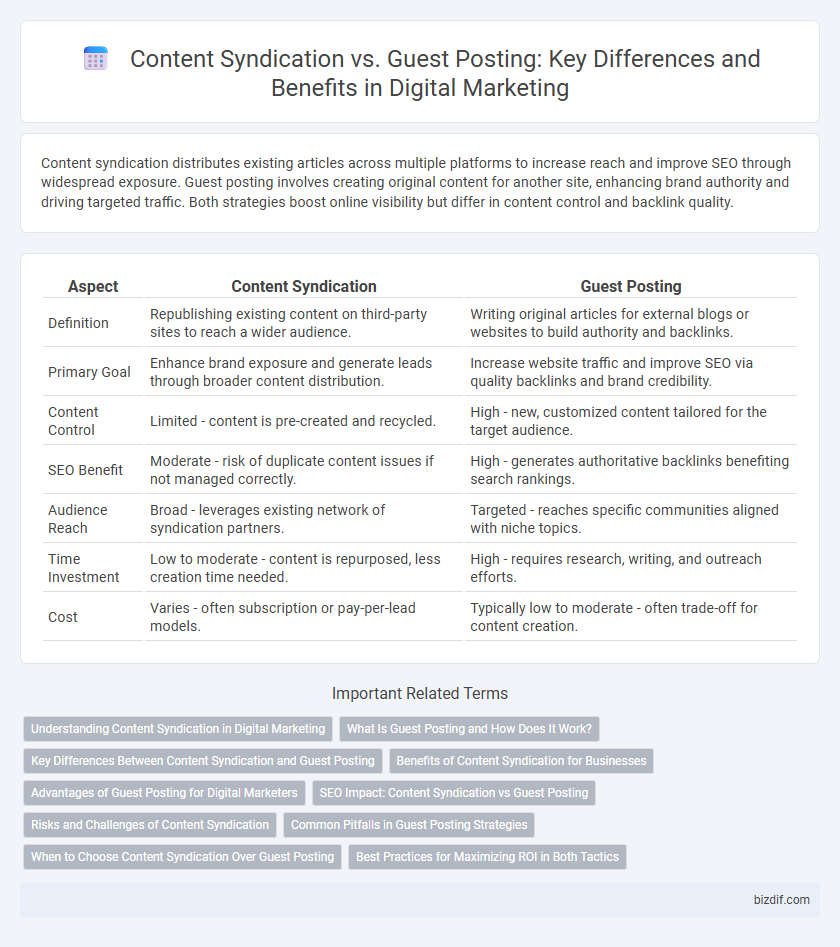Content syndication distributes existing articles across multiple platforms to increase reach and improve SEO through widespread exposure. Guest posting involves creating original content for another site, enhancing brand authority and driving targeted traffic. Both strategies boost online visibility but differ in content control and backlink quality.
Table of Comparison
| Aspect | Content Syndication | Guest Posting |
|---|---|---|
| Definition | Republishing existing content on third-party sites to reach a wider audience. | Writing original articles for external blogs or websites to build authority and backlinks. |
| Primary Goal | Enhance brand exposure and generate leads through broader content distribution. | Increase website traffic and improve SEO via quality backlinks and brand credibility. |
| Content Control | Limited - content is pre-created and recycled. | High - new, customized content tailored for the target audience. |
| SEO Benefit | Moderate - risk of duplicate content issues if not managed correctly. | High - generates authoritative backlinks benefiting search rankings. |
| Audience Reach | Broad - leverages existing network of syndication partners. | Targeted - reaches specific communities aligned with niche topics. |
| Time Investment | Low to moderate - content is repurposed, less creation time needed. | High - requires research, writing, and outreach efforts. |
| Cost | Varies - often subscription or pay-per-lead models. | Typically low to moderate - often trade-off for content creation. |
Understanding Content Syndication in Digital Marketing
Content syndication in digital marketing involves republishing your original content on third-party platforms to increase visibility and reach a broader audience without creating new content. Unlike guest posting, which requires writing unique articles for other sites, syndication allows for rapid exposure and enhanced brand authority through multiple channels. Effective content syndication boosts SEO by generating high-quality backlinks and driving targeted traffic to the primary website.
What Is Guest Posting and How Does It Work?
Guest posting involves creating original content for another website or blog within your industry to reach a broader audience and build authority. This strategy works by leveraging the host site's established readership, enhancing your brand visibility, and generating high-quality backlinks that improve search engine rankings. Unlike content syndication, guest posting requires unique, tailored content that aligns with the host site's audience and editorial standards.
Key Differences Between Content Syndication and Guest Posting
Content syndication involves republishing existing content on third-party platforms to reach a broader audience and enhance brand exposure, while guest posting requires creating original content specifically for another site to build backlinks and establish authority. Content syndication typically provides quicker distribution with less SEO benefit, whereas guest posting offers higher quality backlinks and increased domain authority through tailored, unique articles. Both strategies support digital marketing goals but differ significantly in content originality, SEO impact, and relationship building.
Benefits of Content Syndication for Businesses
Content syndication amplifies brand exposure by distributing original content across multiple high-traffic platforms, driving more qualified leads and boosting website authority. It enhances SEO performance through increased backlinks and higher domain relevance without the time investment required for creating new content. Businesses benefit from cost-effective, scalable reach and sustained audience engagement compared to the one-time impact of guest posting.
Advantages of Guest Posting for Digital Marketers
Guest posting offers digital marketers enhanced brand credibility by associating with authoritative websites, driving targeted organic traffic through relevant audiences. It enables valuable backlink opportunities that improve SEO rankings, increasing search engine visibility and domain authority. Engaging content on niche platforms fosters meaningful relationships with industry influencers, amplifying reach and long-term lead generation potential.
SEO Impact: Content Syndication vs Guest Posting
Content syndication amplifies SEO impact by distributing the same content across multiple authoritative platforms, boosting backlink quantity and improving domain authority while risking duplicate content issues if not managed properly. Guest posting enhances SEO through unique, high-quality articles tailored to target audiences, earning relevant backlinks and driving referral traffic that supports keyword rankings. Prioritizing guest posting typically yields stronger long-term SEO benefits due to original content creation and tighter alignment with targeted keywords and audience engagement.
Risks and Challenges of Content Syndication
Content syndication in digital marketing carries risks such as duplicate content issues that can harm SEO rankings and diminish organic traffic. Challenges include maintaining brand control and ensuring content quality across multiple platforms, which can lead to inconsistent messaging and potential reputational damage. Unlike guest posting, syndication offers less opportunity for backlinks, reducing the effectiveness of link-building strategies essential for search engine authority.
Common Pitfalls in Guest Posting Strategies
Common pitfalls in guest posting strategies include targeting low-quality or irrelevant websites that provide little SEO value and may harm domain authority. Failing to tailor content to the host site's audience reduces engagement and diminishes the effectiveness of backlinking efforts. Overusing exact-match anchor text or neglecting editorial guidelines can lead to penalties from search engines, undermining the campaign's overall success.
When to Choose Content Syndication Over Guest Posting
Content syndication is ideal when seeking to rapidly expand content reach and drive traffic from established, high-authority platforms without producing entirely new material. This approach maximizes brand visibility and improves SEO by leveraging existing audiences, especially when time or resources for original content creation are limited. Opt for content syndication over guest posting when consistent, scalable exposure is prioritized over personalized backlinks and domain authority gains.
Best Practices for Maximizing ROI in Both Tactics
Content syndication and guest posting both enhance brand visibility and drive targeted traffic, but maximizing ROI requires distinct best practices. For content syndication, select reputable platforms with relevant audiences, ensure content originality to avoid duplicate content penalties, and track leads through proper attribution. Guest posting demands crafting high-quality, authoritative articles tailored to the host site's audience, embedding strategic backlinks, and fostering long-term relationships with industry influencers for sustained referral benefits.
Content syndication vs Guest posting Infographic

 bizdif.com
bizdif.com